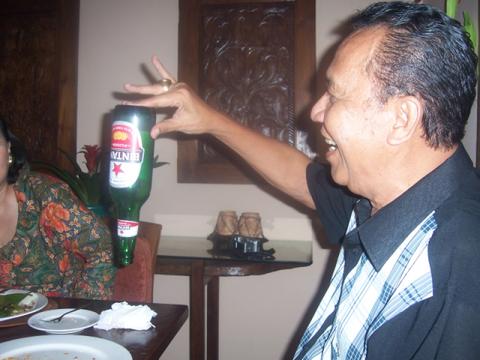
http://en.wikipedia.org/wiki/Indonesian_National_Armed_Forces
From Wikipedia, the free encyclopedia
Indonesian National Armed Forces Tentara Nasional
Insignia of Indonesian National Armed Forces Service branches TNI AD (Army)
TNI AL (Navy) TNI AU (Air Force)
Leadership: Panglima TNI (Commander of the Armed Forces) Gen. Djoko Santoso
Manpower Available for military service 60,543,028, age 18–49 (2008 est.)
Fit for military service 52,000,000 males, age 18–49 (2008 est.),
similar females, age 18–49 (2008 est.)
Reaching military age annually 2,000,000 males (2008 est.), similar females (2008 est.)
Active personnel 400,000 persons known
Expenditures Budget $4.74 billion (2008)
Percent of GDP 0.8%
Industry Domestic suppliers PT Pindad, PT.PAL, LAPAN
An Indonesian Army infantryman participating in the U.N.'s Global Peacekeeping Operation Initiative
The Indonesian National Armed Forces (Indonesian: Tentara Nasional Indonesia, TNI; formerly Angkatan Bersenjata Republik Indonesia, ABRI) in 2009 comprises approximately 432,129 personnel including the Army (TNI-AD), Navy (TNI-AL) including the Indonesian Marine Corps (Korps Marinir) and the Air Force (TNI-AU).
The Indonesian Army was formed during the Indonesian National Revolution, when it undertook a guerrilla war along with informal militia. As a result of this, and the need to maintain internal security, the Army has been organized along territorial lines, aimed at defeating internal enemies and external invaders once they have occupied the nation [1]..
Under the 1945 Constitution, all citizens are legally entitled and obliged to defend the nation. Conscription is provided for by law, yet the Forces have been able to maintain mandated strength levels without resorting to a draft. Most enlisted personnel were recruited in their own home regions and generally trained and served most of their time in units nearby. Each service has small female units, inaugurated in 1992.
These all-female Corps are the Women's Army Corps, the Navy Women's Corps, the Air Force Women's Corps, and the Women's Corps of the Police. These are to "set to work at places and in functions conform[ing] to their feminine disposition." More specifically, women were assigned to administrative work, teaching English and working to improve health and social conditions of armed forces members and their families. The women police were said to "play an important role in solving problems [of] drug addicts and juvenile delinquents." [2]
The Indonesian Army is by far the largest, with about 328.517 active-duty personnel, compared to around 74,963 in the Navy and 34,930 in the Air Force.[citation needed]. The Indonesian armed forces are entirely voluntary. The available manpower fit for military service of males aged between 16 to 49 is 52,000,000, with a further 2,000,000 new suitable for service annually [2]
Defense spending in the national budget was widely estimated 3% of GDP in 2005 [2], but is supplemented by revenue from many military-run businesses and foundations. The Indonesian Defence force personnel does not include members of law enforcement and paramilitary personnel such as POLRI (Indonesian police) consisting of approximately 540,000 personnel, BRIMOB [police mobile brigade] of around 39,000 armed personnel, MENWA [university student regiment] 26,000 trained personnel, and HANSIP [civilian defence] (number unknown).
In 2009, all former Indonesian military businesses are to be surrendered to a specialist body. The Indonesian Military Business Management Body (BPBTNI) was established in effect of a stipulation in Law No.34/2004 on the Indonesian Military (TNI) which will takeover ownership and operation of all businesses owned or run by the TNI by 2009. Unlike the former National Banking Restructuring Agency (BPPN) which burdened the Indonesian state with losses, the BPBTNI would bear all losses alone[3].
Indonesia's 238 million people make it the world's fourth-most populous nation (after China, India and the United States).[1] The islandof Java is the world's most populated island and one of the most densely populated areas in the world, with more than 130 million people living in an area the size of Greece.
The size of the civil service
http://www.hamline.edu/apakabar/basisdata/1999/04/06/0131.html

No comments:
Post a Comment